A well-planned rock landscape enhances outdoor spaces with natural beauty, durability, and minimal maintenance. Whether used for pathways, garden borders, or decorative focal points, rocks provide texture and contrast while complementing greenery. Different sizes, shapes, and colors create visual interest, offering endless design possibilities. Beyond aesthetics, rock landscaping improves drainage, reduces soil erosion, and withstands harsh weather conditions. From serene Zen gardens to rugged desert-inspired layouts, incorporating stones and boulders adds depth and character to any yard. With creative arrangements and thoughtful placement, rock landscaping transforms ordinary outdoor spaces into stunning, low-maintenance environments that remain attractive year-round.
Low-Maintenance Rock Mosaic Paths

Intricate rock mosaic paths offer a visually striking yet practical solution for walkways that require minimal upkeep. By using naturally durable materials like river stones, pebbles, or flagstones, these paths withstand heavy foot traffic and adverse weather conditions without deteriorating. Mortar or sand serves as a stabilizer, preventing shifting and reducing the need for frequent adjustments. Weed barriers beneath the rock layers help suppress unwanted growth, making them an efficient choice for long-term sustainability. Complementing the design with strategically placed stepping stones adds both structure and aesthetic appeal. Unlike traditional paved walkways, these paths enhance drainage, reducing the likelihood of puddles or erosion. Selecting color variations and textures allows customization to suit different landscape styles, from rustic to modern. Integrating these pathways into garden designs ensures seamless navigation while maintaining an eco-friendly and low-maintenance outdoor space.
Crevice Rock Gardens for Drainage Issues
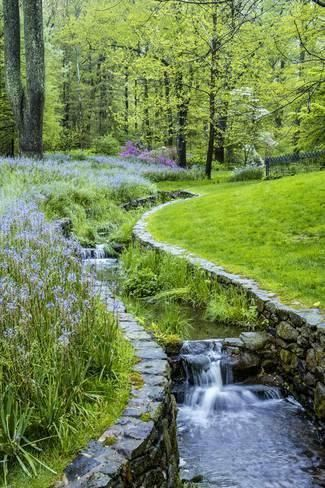
Solving drainage challenges becomes easier with crevice rock gardens, which not only enhance visual appeal but also effectively manage excess water. Narrowly spaced vertical rocks create natural pockets where drought-resistant plants thrive, preventing soil erosion. By strategically placing layered stones, water is directed away from vulnerable areas, minimizing pooling and runoff damage. Choosing porous rocks such as limestone or sandstone aids in moisture retention for plants while ensuring excess water percolates efficiently. The natural gaps between stones create microclimates that support various hardy species, including succulents, sedum, and creeping thyme. These gardens require little upkeep, as rocks suppress weeds while allowing air circulation for root health. Implementing this approach in problem areas transforms once-difficult landscapes into vibrant, structured features that enhance both function and aesthetics.
Fire Pit with Built-in Rock Seating

Outdoor gatherings become more inviting with a fire pit featuring integrated rock seating, combining durability with functionality. Using natural stones such as basalt, granite, or limestone ensures weather resistance while maintaining a timeless aesthetic. Circular or semi-circle seating arrangements create a cozy ambiance, eliminating the need for movable furniture. Large boulders or stacked stone benches provide sturdy seating options, often complemented by comfortable cushions for added warmth. Fire-resistant properties make rock an ideal material for safety, preventing fire hazards while maintaining structural integrity. Surrounding the fire pit with crushed gravel or flagstone enhances the design while promoting drainage. To optimize usability, incorporating built-in storage compartments within the stone seating keeps firewood and essentials easily accessible. Whether for small gatherings or large social events, this setup establishes a focal point that blends seamlessly into outdoor landscapes while requiring minimal maintenance.
Glow-in-the-Dark Rock Borders

Enhancing garden aesthetics and safety, glow-in-the-dark rock borders provide a luminous effect that defines pathways and garden beds after sunset. Photoluminescent pebbles, charged by sunlight or artificial light, create an ambient glow that eliminates the need for additional outdoor lighting. These rocks absorb daylight and gradually release stored energy, offering an eco-friendly illumination method. Whether outlining a walkway, accenting a rock garden, or bordering a water feature, these glowing elements add both visual interest and functionality. Combining phosphorescent stones with natural river rocks creates a balanced look that blends seamlessly into landscapes during the daytime. Since these rocks do not require wiring or electricity, they serve as a cost-effective, low-maintenance solution for enhancing outdoor spaces. Utilizing this design element transforms nighttime aesthetics while providing a practical guiding system for pathways.
Tiered Rock Garden for Sloped Yards
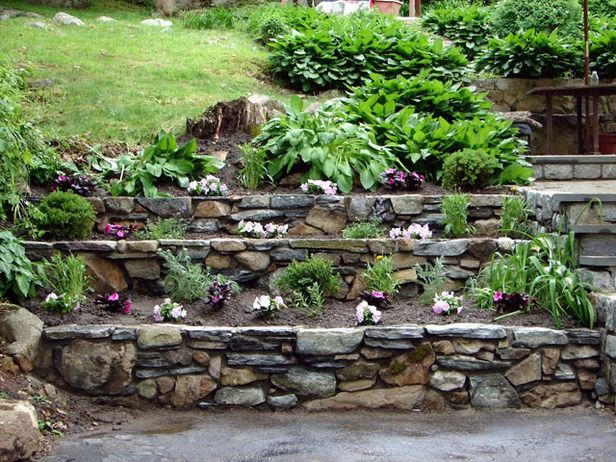
Sloped landscapes benefit significantly from tiered rock gardens, which prevent soil erosion while maximizing planting space. By layering retaining rocks into multiple levels, this approach stabilizes uneven terrain while creating visually appealing garden beds. Boulders, flagstones, or stacked slate serve as sturdy borders that hold soil in place, allowing for controlled water drainage. Native drought-tolerant plants thrive within these structured levels, reducing the need for constant upkeep. Incorporating cascading plants like creeping phlox or trailing succulents softens the appearance of rigid rock edges while adding seasonal color. Gravel or mulch between the tiers minimizes weed growth and further stabilizes the soil. This design not only enhances outdoor aesthetics but also transforms an otherwise unusable slope into a functional, dynamic landscape.
Rock-Edged Raised Planters for Weed Control
Defined rock-edged raised planters offer both aesthetic appeal and effective weed prevention for garden spaces. Stacking stones such as granite, limestone, or river rock around raised garden beds establishes a sturdy boundary that discourages invasive weeds from taking root. The solid structure also aids in retaining soil moisture, promoting healthier plant growth while reducing water usage. By elevating the planting area, soil compaction is minimized, ensuring better aeration for root systems. Utilizing rock edging instead of wood prolongs the durability of the planters, preventing decay and reducing maintenance efforts. Filling gaps between rocks with fine gravel or sand enhances stability and prevents weed infiltration. This setup creates a structured, polished look while simplifying long-term garden maintenance.
Zen Dry Riverbed for Water Runoff

An aesthetically pleasing dry riverbed design manages excess water runoff while introducing a tranquil, Zen-inspired landscape element. Carefully arranged river rocks and gravel mimic the appearance of a natural stream, guiding rainwater through designated pathways. Larger boulders placed strategically enhance the visual impact while helping slow down water flow, preventing erosion. Hardy plants like ornamental grasses, blue fescue, and dwarf sedum complement the rocky setting, adding texture and color variation. The porous composition of the stones aids in absorption, reducing flooding risks in low-lying areas. This low-maintenance landscaping solution requires no irrigation and remains visually appealing year-round. A dry riverbed blends functionality with aesthetic charm, creating a serene yet practical garden feature.
Floating Rock Stepping Stones

Stepping stones designed to appear as if they “float” over gravel or water features bring an artistic, modern touch to outdoor spaces. Large flat stones placed atop hidden support structures create the illusion of levitation while providing functional pathways. Spacing the rocks at calculated intervals allows for easy navigation while preserving the natural flow of the landscape. Materials such as slate, flagstone, or basalt enhance the overall aesthetic while maintaining durability. When positioned over a shallow pond or dry riverbed, these stones add depth and intrigue to the setting. Complementing the design with surrounding low-growing ground cover or moss enhances the organic appeal. This minimalist yet visually striking concept adds movement and dimension to any landscape.
Rock-Wrapped Outdoor Kitchen
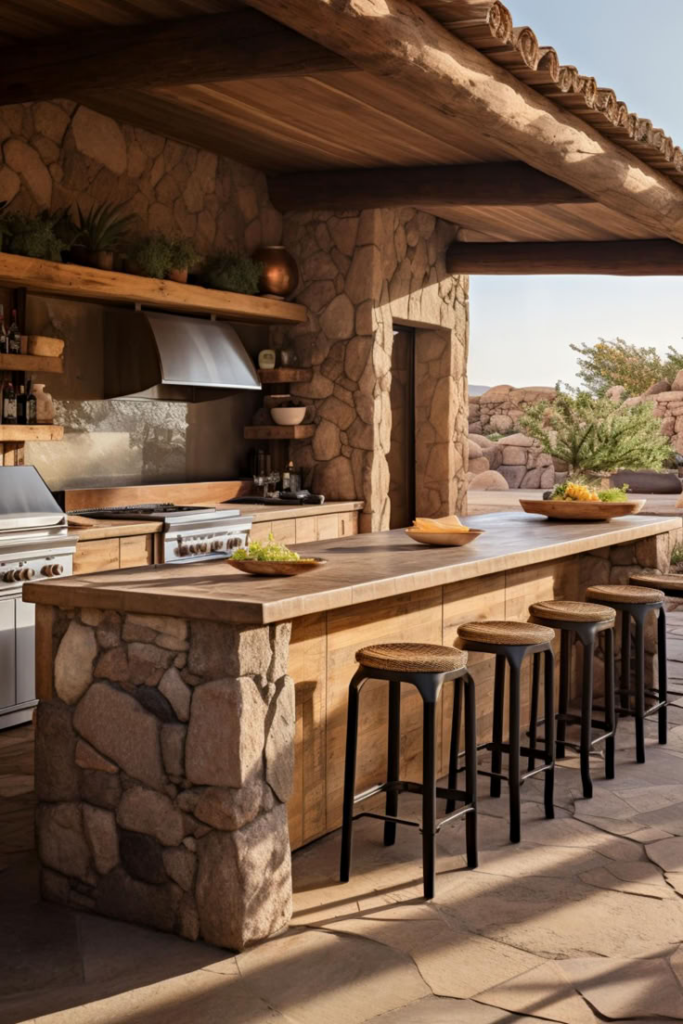
A fully integrated outdoor kitchen enveloped in natural stone offers a blend of sophistication and durability. Using rock for countertops, backsplashes, and base structures ensures weather resistance while achieving a cohesive, organic look. Materials like granite, quartzite, or fieldstone withstand outdoor elements while adding rustic elegance. Built-in stone islands provide both cooking and serving space, seamlessly merging with patio settings. Surrounding the cooking area with flagstone flooring enhances the natural aesthetic while offering slip resistance. Heat-resistant stones near grills and fire features add both functionality and safety. Paired with stainless steel appliances, the fusion of rock elements creates a timeless, hard-wearing outdoor entertainment space.
Boulder Retaining Walls with Hidden Planters
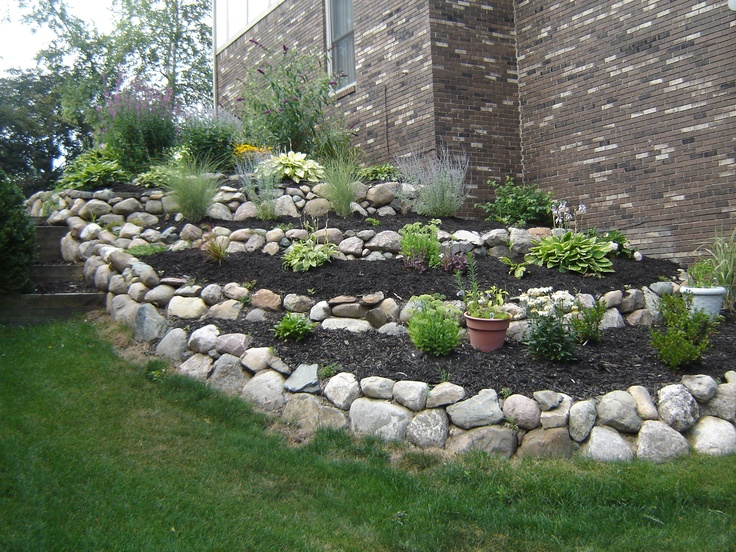
Retaining walls built from large boulders serve as both structural reinforcements and naturalistic garden features. These walls stabilize slopes while incorporating hidden planting pockets that soften their appearance. Interspersing drought-resistant greenery like sedums, lavender, or creeping jenny within crevices enhances visual interest while promoting ecological balance. The boulders’ irregular shapes create an organic, rustic charm that blends with surrounding landscapes. Their mass helps prevent soil erosion while ensuring long-term stability. Gravel-filled gaps improve drainage, further reducing maintenance needs. Whether as a terraced border or standalone garden feature, these functional walls integrate nature and structure seamlessly.
Desert Rockscape with Drought-Proof Color Pops

Arid landscapes benefit from a desert rockscape featuring vibrant, drought-resistant plants that add color without requiring excessive maintenance. Strategic placement of boulders, decomposed granite, and river rocks creates natural contours that enhance visual depth while promoting efficient water drainage. Succulents, agaves, and flowering cacti introduce bursts of color that contrast against the neutral tones of the stones. Mulching with small pebbles or crushed gravel helps retain moisture and suppress weeds. This setup reduces reliance on irrigation while maintaining an elegant, sculpted appearance. The combination of hardy vegetation and durable stone elements ensures a sustainable landscape that thrives in dry climates while providing year-round visual interest.
Pebble and Rock Spiral Herb Garden
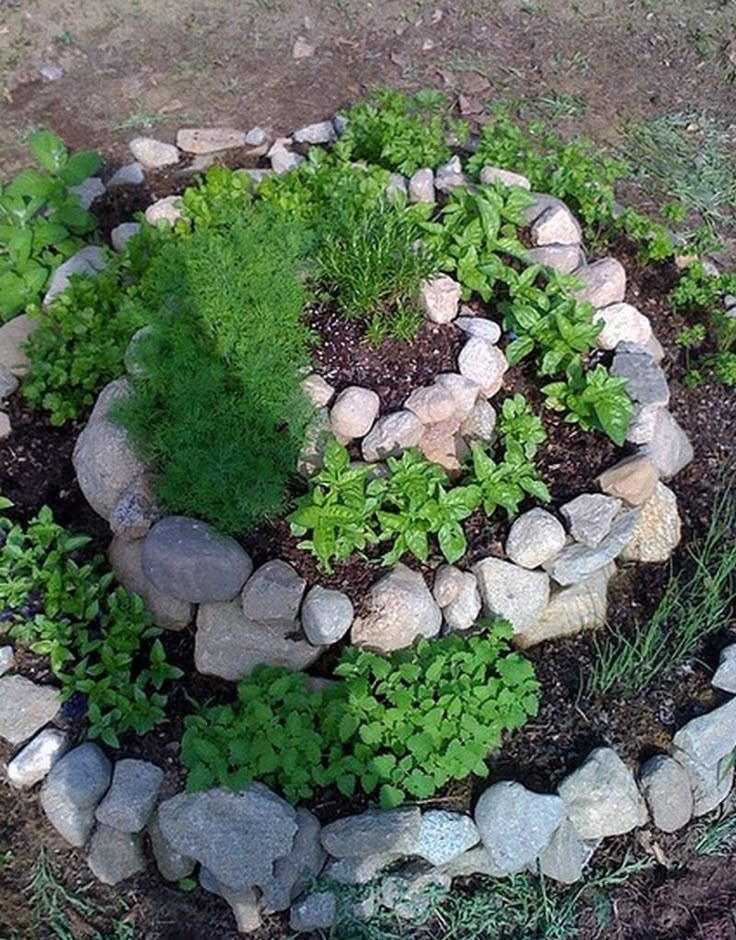
A spiral-shaped rock herb garden optimizes space while adding an artistic, structured focal point to outdoor settings. The design uses stacked stones to create a gradually ascending spiral, allowing various herbs to grow at different heights based on their sunlight and water needs. Larger rocks serve as structural anchors, while pebbles or crushed gravel fill the spaces between layers to improve drainage. Mediterranean herbs like rosemary, thyme, and oregano flourish in the upper, drier sections, while moisture-loving varieties such as basil and parsley thrive in the lower levels. This self-sustaining design maximizes planting space in a compact footprint while creating an aesthetically pleasing and functional herb-growing solution.
Interactive Rock Water Feature
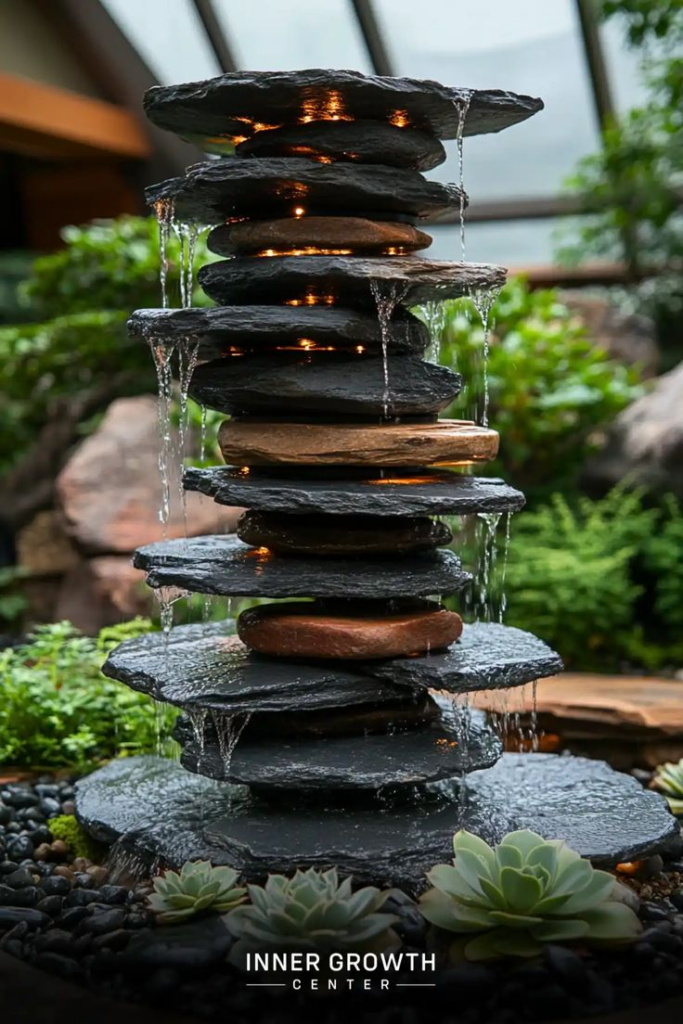
A dynamic rock water feature introduces movement and tranquility to any landscape while requiring minimal upkeep. Water cascades over naturally arranged stones, creating a soothing ambiance that attracts birds and pollinators. Recirculating pumps ensure efficient water usage while reducing the need for constant refilling. Smooth river rocks or textured boulders shape the flow, directing water through strategically placed channels. Submerged LED lighting enhances the visual effect at night, adding an elegant touch to the setting. Incorporating aquatic plants such as water lilies or papyrus softens the edges while promoting a balanced ecosystem. The combination of flowing water and organic rock structures transforms outdoor spaces into serene, meditative retreats.
Multi-Layer Rock Succulent Tower

Stacked rock formations create a striking, multi-layered display for drought-tolerant succulents, enhancing both vertical and horizontal garden spaces. Large stones provide the base structure, while smaller crevices hold soil and support plant growth. Sedum, echeveria, and haworthia flourish within these pockets, requiring minimal watering and care. This tiered arrangement maximizes planting potential in compact areas while offering an artistic, sculptural aesthetic. Integrating pebbles or decorative gravel between layers enhances drainage while maintaining a polished look. Whether as a standalone focal point or part of a larger rock garden, this living tower blends function with artistic appeal, ensuring long-lasting beauty with little maintenance.
Hollowed Rock Birdbath & Pollinator Hub
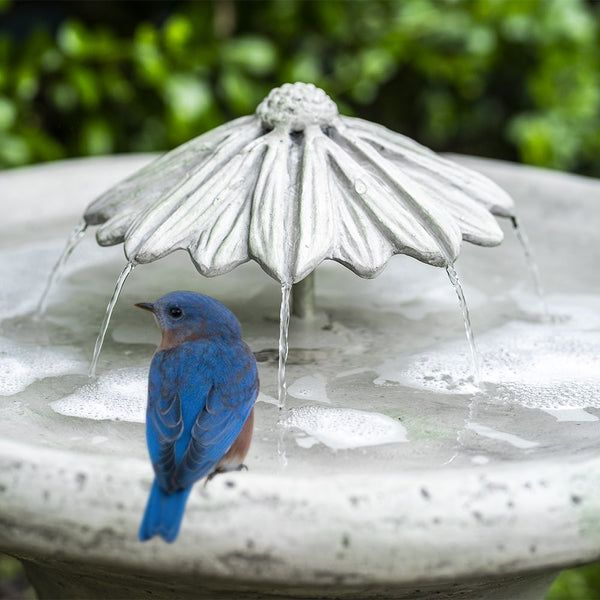
A naturally sculpted, hollowed-out rock serves as a dual-purpose birdbath and pollinator-friendly water source. This design utilizes durable stones such as basalt or limestone, ensuring longevity while seamlessly blending into garden landscapes. Shallow indentations collect rainwater, providing hydration for birds, bees, and butterflies. Surrounding the rock with nectar-rich flowers like lavender, echinacea, or salvia attracts pollinators, supporting biodiversity. A gentle slope in the rock prevents water stagnation, keeping the feature fresh with minimal intervention. Positioning the birdbath near foliage offers shelter for visiting wildlife while integrating it into the garden setting. This eco-friendly addition enhances the outdoor ecosystem, fostering natural harmony while requiring little maintenance.
